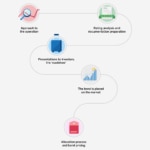Step-by-step guide to issuing a bond
Bonds are credit instruments used by companies in need of financing. The company in question issues this debt product in order to obtain liquidity from the financial markets. But how does a bond issue take place? What steps must be followed from the moment the company decides to issue a bond until their subsequent placement and sale on the market?

These negotiable obligations have always been the primary source of funding for U.S. companies. In Europe, they started to play a relevant role as a source of funding for companies during the banking crisis.

Guide to issuing a bond
1. Approach to the operation
First, the company talks to the bank and explains its need for financing. The bank analyzes the company’s financial situation, determines whether a bond issue is appropriate and if the company meets the essential requirements for the market.
2. Rating analysis and documentation preparation
In order to issue a bond on the market, it is recommended that the company have a rating from a rating agency. If it does not yet have one, the bank examines the company’s credit and, based on its sector, tells the company which rating agencies would be the most appropriate.
Throughout this process, the company is under the auspices of the bank that is advising and assisting it, starting from the preliminary meetings with the agencies - which they attend - to the actual preparation of the presentation to be given to the agencies.
The legal documentation is prepared in parallel in order to ensure that it is ready at the time of the operation. This includes the contracts that establish the conditions for the issuer and the banks participating in the operation. It is a slow, tedious process, but support is provided by outside attorneys.
3.- Presentations to investors, the ‘roadshow’
Presenting the operation to investors is a key point in the process for new issuers. What is known in the industry as a ‘roadshow’ is organized. This involves meetings with investors in the biggest financial hubs in Europe (Paris, London or Frankfurt); a presentation is given and any questions are addressed. It is also key to find out what the market looks like and how much appetite there is for the company’s risk. If the response is not positive, the operation is postponed. Thus, the purpose of the roadshow is clear: to involve investors and gauge the price range and maturity.
4.- The bond is placed on the market
Once it has been decided that the bond will be issued because sufficient interest exists, the bank and the company look for a window of opportunity and establish a tentative date, which will greatly depend on the market conditions.
When that day arrives, there is an initial call with the team that will carry out the transaction and the company itself first thing in the morning. It’s the “go-no go” call - a key moment in which, based on the market conditions that day, it is confirmed whether to go ahead with the issuing or postpone it if the circumstances have greatly varied.
If no significant changes have taken place in the market that could put the operation at risk, the bank advises the issuer on the price, they agree on the premium for the operation and coordinate a strategy. Now is the time when the issuance is announced to the market and the “book” is opened - a digital archive where the different orders from investors are noted.
After several hours, there is another call to see how the book is doing. At that time the company can decide whether or not to adjust the price, based on the behavior of the market and investors. If there is a change in price, it is announced to the market. There may be investors who decide not to participate.
Finally, there is a third call to complete the operation with the agreement from those involved, the issuer and banks. At this meeting the banks compare information and eliminate duplications in orders - in other words, they refine the book.
5.- Allocation process and bond pricing
When the book has been refined and closed, a decision is made to determine how much to give to each investor. This is based on the quality of the investor and the objectives of the issuing. Banks give the issuer a list with this distribution for their approval, and the investors are informed of exactly how much they were allocated.
Then, the price is established by taking the indexes into account. Finally, the sales team informs the market of the coupon and the next day, the bond is listed on the secondary market. Its evolution is then monitored from this point on.